BY LETTER
Duxed
Galactography > Sephirotic Empires > Caretaker Gods
Galactography > Regions of Space > Middle Regions/Hinter-regions
Galactography > Sephirotic Empires > Non-Coercive Zone (NoCoZo)
Galactography > Systems and Worlds > Systems & Worlds C - D
Science > Biology > Xenobiology
Galactography > Regions of Space > Middle Regions/Hinter-regions
Galactography > Sephirotic Empires > Non-Coercive Zone (NoCoZo)
Galactography > Systems and Worlds > Systems & Worlds C - D
Science > Biology > Xenobiology
Garden World, a moon with an extreme tidal range | |
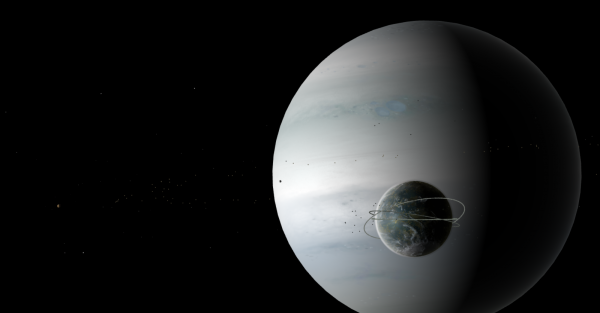 Image from Dangerous Safety | |
| The gas giant Pacol, and its moon Duxed | |
Duxed - Data Panel | |
| System | Piaget, JD 281911 Region: Middle Regions - 639 ly from Sol, in Carina Star: Piaget Type: K5 V Luminosity: 0.153 ± 0.01 x Sol |
|---|---|
| Planet | Pacol: NoLWoCS: Hydro-MesoJovian. EWoCS: Hydronian Subgiant Jovian Distance from Piaget: 0.481 AU Mass = 5.32E+26 kg (89 Earths) Radius = 56829 km (8.92 Earths) |
| Satellites of Pacol | Pacol Orbital Band Pacol was originally orbited by some 70 moons, mostly small to medium sized captured asteroids; these have been disassembled and converted into the Pacol Orbital Band, leaving only 57 minor moons. The Band consists of a mix of habs, free-fall industrial facilities, and computronium nodes housing the majority of the system's sophtware population. Unsafe Precautions M-Brain A moon-brain constructed from a former Enceladus-like moon, holding the local S:3 Transapient, Unsafe Precautions. Kerzorvin: NoLWoCS: Cerean Europan Planetoid EWoCS: Hermian Cerean Apnean Europan Microdwarf Duxed: NoLWoCS: EuGaian Aquean Terrestrial moon EWoCS: Stilbonian Hydronian Rhean AquaGaian (Marine Tundral) Terrestrial Subterrene Captured Satellite Macrobiotic Garden World Semi-major axis: 902,000 km Orbital period = 12.13 days Eccentricity = 0.046 Inclination = 176 degrees Rotation period = 7.81 days (3:4 resonance) Tidal Cycle: 21.95 days 5.49 days between high and low tide Orbit = retrograde Mass = 1.206E+24 kg (0.202 Earths) Radius = 4020 km (0.631 Earths) Atmospheric pressure = 1.691 bar (low tide) 1.612 bar (high tide) Composition = 89% N2, 9.4% O2, 1.3% CO2, 0.3% Ar CO2 toxic partial pressure layer: >2 kilometers altitude Albedo = 0.39 Temp = 292 K (low tide), 291 K (high tide) Tidal range: 0.8 km in ocean, varies from 2-4 km in coastal areas Lowest tidal speed: 0.021 km/h Highest tidal speed: 1.728 km/h |
| Asteroid Belt | Extensive asteroid belt from 0.5 to 2 AU. Includes a large amount of dust and multiple planetoids. |
| Polities | Duxed Union Caretaker Protectorate - DUCP Population: 30 million in orbit, 200,000 on the surface Virtual & sophtware population: 120 million Hazard Rating: follow standard protocol for visiting a Caretaker Protectorate |
| Important Figures | Caretaker God: Unsafe Precautions Duxed Union Caretaker Protectorate Premier: Lang-dth Ford |
| Transportation | Stargates: TANSTAAFL (There Ain't No Such Thing As A Free Lunch) - to Relay 437 (500m) Beamrider Routes: 2 beamlines Lightways: 1 |
Duxed - A Garden World with an Extreme Tidal Range
Duxed is a large, captured moon of the gas giant Pacol in the Piaget system. The biosphere on this world is macrobial, multicellular and has many biochemical features in common with Terragen biota. Duxed is distinguished by an extreme tidal range, which has created a wide intertidal zone where the local lifeforms cannot survive for extended periods.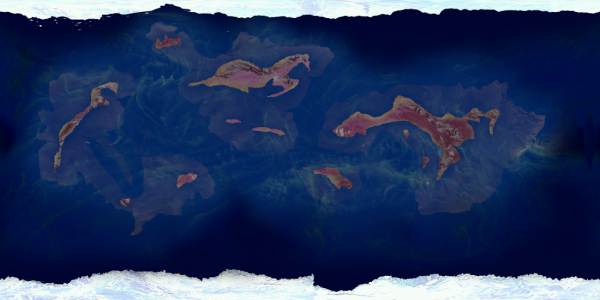 Image from Steve Bowers | |
| Duxed at high tide | |
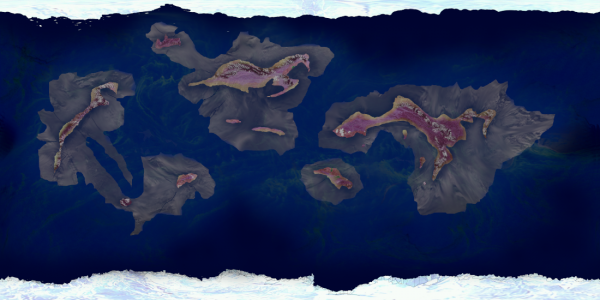 Image from Steve Bowers | |
| Duxed at low tide, exposing the thanatosphere. | |
| Note | The surface would never look like either map. Rather, it would be always in transition in between the images - the high and low tide peaks only cover one half of the moon at a time. The distinctive color produced by the native flora can be seen in the maps. |
|---|
Due to the tidal forces generated by Duxed's eccentric, retrograde orbit around Pacol, massive tides reaching 2 kilometers elevation (on average) regularly sweep the planet, having significant impacts on the ecology and surface. The highlands, consisting of mountains, plateaus, and mesas above the 2km level, are the only land-forms not covered by the tides or the ocean.
The planet is also known for its so-called thanatosphere, a poisonous layer of CO2 which stretches from sea level to 2 kilometers altitude. For bionts adapted to the local continental environment or to a standard Earth-like atmosphere, exposure to the thanatosphere without proper augmentation or protective equipment will result in headaches, dizziness, drowsiness, muscle tremors, sweating, increased heart rate and blood pressure, convulsions, unconsciousness and finally, death.
Duxed is surrounded by multiple orbital rings. The rings and their supporting surface infrastructure use a mix of active camouflage and geoengineering to minimize any impact on local wildlife. These orbital rings are home to the evicted Duxedians and also a Caretaker God outpost for Unsafe Precautions. The only settlement left on the surface of Duxed is Rotaxane City.
Fauna and Flora of Duxed
Duxed has a young but diverse biosphere, with the most recent stage of development having been the invasion of the land by animals. Molecular clock and paleontological studies have shown that land life is fairly recent in the lowlands, having first evolved around 20 million years ago, placing the evolutionary history of Duxed at a point similar to the Middle Devonian period of Earth. The relative youth of the macrobiotic terrestrial biosphere has resulted in a lack of biodiversity in the lowlands, which are less hospitable than the highlands and oceans.Most Duxedian life utilizes a biochemistry based on cyclohexane nucleic acid (CeNA) with right-handed chirality, forming a superdomain known as the Cyohexa. There are also a range of simple, but quite hardy, microorganisms found in high-temperature environments whose genetic code is based on peptide nucleic acid. These organisms make up a superdomain known as the Peptidia. Some PNA organisms have evolved to become photosynthesizing mosses and floating mats in the lowland intertidal zone and oceans, with a variant form present around hydrothermal vents, volcanic hot-spots and hot springs.
The first land animals to evolve on Duxed were a group of worm-like organisms known as vermiforms, analogous to Terran annelids although they are quite different in many respects. Currently, the population of vermiforms is limited to daworms and flat-vermiforms.
Daworms have several distinguishing features, including chitinous spines, annelid-like body plans and chitinous serrated jaws. They also have four sets of legs, evolved from parapodia (fleshy protrusions that serve the role of 'feet'). Some daworms occupy the niche of carnivorous predators. Skin color varies, though is usually brown, red or a mix of both.
Flat-vermiforms are characterized by flat body plans, a lack of respiratory organs, and minimal body cavities, instead relying on diffusion for respiration. Most marine flat-vermiforms use a respiration method known as ram-ventilation, whereby swimming and undulation forces water into slits in the body, diffusing oxygen into the tissues and letting out water. Flat-vermiforms do not have any parapodia, instead relying on undulation and/or movement via expansion and contraction of muscles in the body.
Examples of daworms
Three representative types of daworm - grazeflies, greenspots and riyarkunags.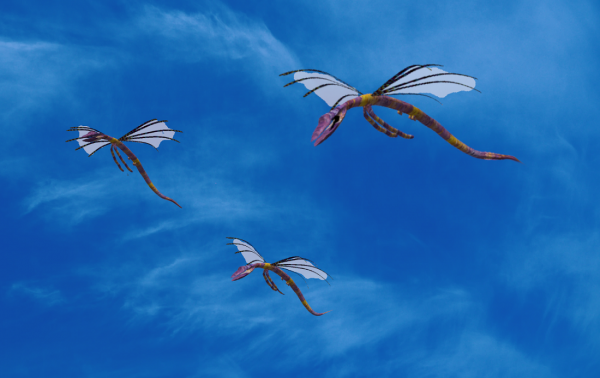 Image from Steve Bowers | |
| Grazeflies | |
Grazeflies: A family of flying daworms, grazeflies have a partial beak made out of chitin. These beaks are simply slightly modified jaws and may be serrated, depending on the diet. The wings have developed from a pair of leg-parapodia and are made out of chitinous endoskeletal protrusions and muscular membrane. Another pair of parapodia have developed into legs, and the rest have become small nubs in most species. Most grazeflies feed on plants, although some have evolved to be carnivorous and prey on smaller daworms or grazeflies.
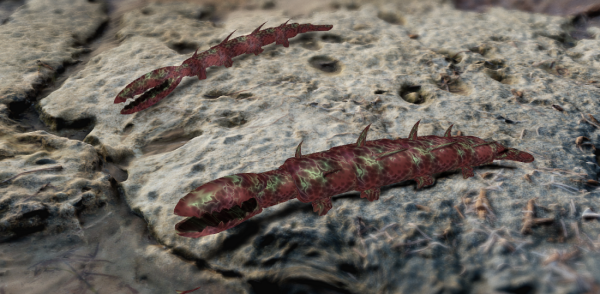 Image from Steve Bowers | |
| Greenspots | |
Greenspots are known for their spotted green coloration. The spots are venomous glands that can pop when the daworm is threatened by predators. Greenspots have a herbivorous diet and live in burrows in the ground.
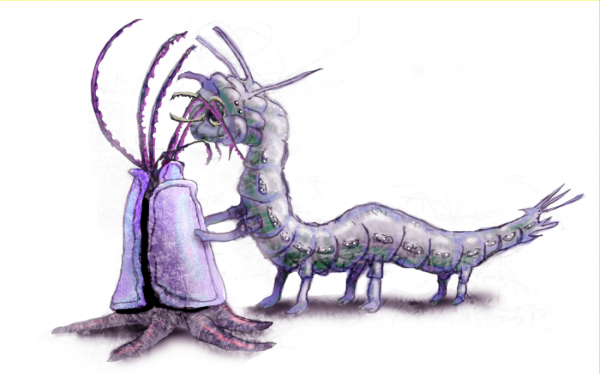 Image from Steve Bowers | |
| A Riyarkunag browsing on a shield-bush, a member of the armoured plant phyle | |
Riyarkunags are the largest animals on Duxed, with the largest specimen observed being about 1.3 meters in length, and approximately 6 centimeters thick. On average they are around 1 meter in length. Riyarkunags have evolved to be gigantotherms, allowing them to thrive in cold climates as well as access higher leaves.
Sweepstars Sweepstars are a form of biobot, developed for cleaning and sanitation by the Duxedian Bioist Association, widely used in the habitats orbiting Pacol and Duxed. In appearance they resemble Terran bristle stars, although with a head and three eyes. The sweepstars' mouth has a mix of long and short bristles, which can catch debris. In the middle of the mouth there is a sucking organ used to vacuum dust and debris out of the bristles. Rows of teeth inside the sucker break down any large pieces of debris into smaller ones, which are either digested or excreted as waste. Sweepstars are generally slow moving, but can be deceptively fast, moving up to 35 km/h in a burst, due to powerful muscles and a hydrostatic skeleton. Sweepstars are mainly differentiated by their respiration - some work in Earth-like environments, while others require high concentrations of CO2. A sweepstar will seek out any toliet or waste disposal machine, but in the absence of one, will simply excrete into any hole or corner.
There once existed a population of wild sweepstars in the lowlands. It is unknown how this population came to be, but gradually they became a part of the local culture via the Tide Hunt - a hunting competition used both for recreation and to control the sweepstar population. These wild sweepstars generally avoided any other lowland life (it was programmed into them as an instinct) and competed with the flat vermiforms for dead bodies (some flat-vermiforms and sweepstars simply ate the waste of other sweepstars). In the Tide Hunt, up to 65% of the sweepstar population on Duxed was eliminated, although fast reproductive rates recovered their population by the next year. However, Unsafe Precautions exterminated all remaining sweepstars on Duxed, and barred any from ever returning to the planet. Since then, Tide Hunts have been hosted in virtual worlds.
Highland Flora
The highland flora occupy a mix of ecosystems, including salt-marshes, swamps, forests, rainforests, grasslands, steppe and tundra. The flora of Duxed do not utilize chlorophyll plastids. Rather, plant life is descended from unicellular photosynthesizing organisms that utilize retinaldehyde-based proteins, giving plant-forms a distinctive purple color.Many tall fern and grass-analogs exist, ranging from roughly 1.8 meters to 2 meters in height. There is also a large diversity of tree analogs, in comparison to the relatively few vascular plants on Earth during the Middle Devonian. These tree-analogs are the result of an evolutionary arms race between plant-burrowing vermiforms and the plants they seek to consume or burrow into, with the tree-analogs developing chitinous exoskeletons and vascular tissues to resist the depredations of the vermiforms. As a result the tree analogs have diversified into the smallwoods, fortwoods and ultrawoods. All three groups use chitin for water transport but also for a range of purposes unique to each type. The smallwoods are too small for daworms to burrow into but use a weak arrangement of chitin for mechanical support, while the fortwoods use a more resistant arrangement exclusively for defense. Only the ultrawoods utilize both arrangements of chitin for all purposes. Some plants have retained their original form, due to a high reproductive rate eliminating the need for chitinous or cellulose tissues to evolve. The highest recorded tree on Duxed is known as Zodd, with a height of 48 meters and a diameter of 3.6 meters, a member of the ultrawood species Drysabarba gigantus.
Oceanic Flora and Fauna
The oceans of Duxed are home to floating dark green mats of plant-like PNA (peptide nucleic acid) life that have developed secretions that bind them together into large colonies to resist breaking up from the tide. The mats utilize chlorophyll for photosynthesis and the largest can grow to be up to a kilometer and a half in diameter. Stem-like cells form the backbone of each mat, giving it a radial symmetry. The mat colonies are in essence siphonophores (colonies of organisms that look like a singular jellyfish from Old Earth), although very basic. They reproduce asexually by budding. In some orders - known as spore-mats - the buds are covered in a hard shell resistant to acid and go through a dormant stage requiring the stimulation of passing through a predator's digestive system to start growing. Many mats often have algae, lichens and other plants growing on them.One of the more successful and common families of mat is the Golutumidaceae. These mats have vine-like tentacles dangling off their backbone structures, which produce an excess amount of the binding secretions used to hold the mat together and form it into a web used to stop any animals from feeding on it. Some species have alternating bands of bright colors (such as magenta and yellow) on their vines as a warning to other animals. It has been suggested that these mats are actually carnivorous, feeding on the dead bodies of starved predators. However, most biologists agree that this is accidental, and only a small fraction of the mat's required nutrients are derived in this fashion due to the incompatibility between the biochemistries.
Cyohexan sea life is divided into two taxa: a class of fish-like analogs - the altupterygians - which exhibit biradial symmetry, and a class of animals propelled by undulation - the fluctuphionts. The latter class is divided in turn into the fluctopinnids - an order of animals that have rows of flaps on their body which increase their speed - and the fluctoleptonids, which rely on snake-like undulation for movement.
Matgrazers
A fluctophiont in the fluctopinnid order. Matgrazers feed on algae and lichens as well other plants that grow on PNA mats but in the absence of these will simply feed on any plants on the seabed or in reefs. The matgrazers will sometimes accidentally consume part of the mats, which has been exploited by spore-mats. Matgrazers form part of the lower rungs of the food web.Flapterrors
Flapterrors are altupterygians that have evolved to prey on fluctocarids. They are extremely agile and fast, however their speed is limited to short bursts and cannot be sustained. The flapterrors are ambush predators, exploiting nooks and crannies in the seafloor, in some cases burrowing or living in ocean reefs.Nileels
A fluctophiont in the fluctoleptonid order. Nileels, like all fluctoleptonids, have an eel or snake-like body plan. They are scavengers and have specialized bone-crushing jaws. Nileels have a bite force of 6,205 kilopascals, enough to break the bones of most duxedian lifeforms. Some nileels will attack living animals if it is necessary.Loganies
Loganies are marine analogs of Prototaxites (a very large fungus from the Middle Devonian on Earth). They use cellulose instead of chitin in their cell walls but are similar to fungi in their sessile lifestyle, saprotrophic diet and formation. The loganies form thick cellulose protrusions on the seabed which photosynthesizing organisms bind to, forming a symbiotic relationship - a lichen analog.Baleefans
Baleefans are sessile, branching animals (similar to a Terran tree or frond), with a calcium carbonate exoskeleton. These animals have baleen-like protrusions from their branches composed of chains of membranous flesh, reinforced by pure calcium carbonate segments. A pair of gills is located at the first intersection of the branches and the trunk.Seagrass and other plant analogs cover the bottoms of the shallow oceans with plains of green while sessile baleefans and loganies form reef-like ecosystems - large concentrations of living organisms sitting atop dead ones, which pile up and become a mixture of calcium carbonate rock and highly nutritious decomposing flesh. The reefs create many nooks and crannies which become shelters for smaller lifeforms, while larger creatures browse the plentiful plant-analogs covering the reefs. At the top of the food chain, predators swim across the reefs looking for prey.
Lowland Animals and Flora
The lowlands are a low-biodiversity humid environment of tide pools intermixed with heavily eroded rocky terrain. Mini-reefs, mostly barren but sometimes filled with fungi analogs, occasionally jut up from the barren surface. The lack of biodiversity in the lowlands is attributed to the local animals having not yet evolved to tolerate the high levels of CO2. There is relatively little evolutionary pressure for either animals or plants to inhabit the lowlands and the increased CO2 levels also mean higher energy requirements for plants, a negative factor when considering that at peak of high tide, the sea floor may be covered under 2 kilometers of water. In addition, plants can suffer from the same acidification from the high levels of CO2 that animals do. The CO2 dissolves into the plants' water content just as it does in blood and forms carbonic acid, lowering the pH to lethal levels.The oceanic reefs also extend into the lowlands, though are less diverse compared to their permanently submerged cousins. Small, flat vermiforms live throughout the lowlands, relying on their flat, thin bodies to diffuse oxygen directly into their cells. During high tide baleefans absorb large amounts of water and nutrients which are then stored in an organ in the underground portion of their bodies. During low tide, they enter a hibernation-like state to conserve nutrients. The water is circulated through the baleefans' gills allowing them to breathe. The gills can also close to prevent moisture from escaping.
Loganies are able to survive mainly due to their marine adaptations, absorbing oxygen from groundwater and saltwater in tidal pools. The symbiotic algae also rely on this, stunting the loganies' growth by competing for oxygen, resulting in reefs and fruiting bodies that are much smaller.
Important Locations on Duxed
Rotaxane City
Rotaxane City, the current capital of the Duxed Union Caretaker Protectorate, is named after the rotaxane: a mechanically interlocked molecular architecture consisting of a dumbbell shaped molecule with a ring shaped molecule wrapped around it. Like a rotaxane, the city consists of a ring surrounding a central structure, in this case a 3km tall arcology spire. Anchored to the spire are a series of buoyant rings, each supporting additional urban districts. During high tide the rings float on the rising waters up to 2 km above the surface, and at low tide, the rings sit on a series of foundations connected by a road system supporting the ubiquitous amphibious vehicles. Some buildings located outside the main urban core remain anchored to the ground, and are designed to be submerged under the tide. Tidal energy converters (TECs) utilize the energy of the rising and falling ocean to provide power, while storing the excess in superconducting storage loops for use between tides.Today, Rotaxane City is the only major population center left on Duxed, although its population has been drastically reduced by Unsafe Precautions. The city has been surrounded with a large wall of rock, resembling a crater's raised rim, distorted and stretched along the vertical axis, with pores and holes allowing for water to pass through. Special membranes filter out any microorganisms and larger lifeforms, to isolate the city from the native life.
All the cables that connected Duxed with its orbital rings have been destroyed, with the exception of the Rotaxane City cable. The cable has a small number of fullairs tethered to it, used mostly by former residents of Nu Fondi Bay.
Nu Fondi Bay
Nu Fondi Bay, alternatively spelled and pronounced No Fondue Bay, is located on the planetary equator and is Duxed's analog to the Bay of Fundy on Old Earth or Big Surf Bay on Ridgewell. The bay is shaped like a funnel, causing the tide to be amplified to a height of 3-4 km. The tide initially begins as warm tropical water but peaks and crashes into the ground as much colder (although still above freezing) water due to the low temperatures 3-4 km altitude.Nu Fondi Bay was a popular location during Duxed's habitation period with residents living in actively camouflaged fullairs overlooking the tides, or in re-enforced submersible habitats anchored to the surface. However since Unsafe Precautions' arrival, the population has been relocated to orbit or Rotaxane City and the habitats removed.
Hubyganti Range
A range of three artificial mountains, with the tallest being Mt. Hubyganti (600 meters above high tide level), followed by Mt. Seilay (499 meters) and Mt. Drakin (456 meters). A large part of the range is montane forest, with subalpine lakes fed by glaciers and seasonal precipitation. However, the treeline (the boundary between montane forest and alpine tundra) is at 470 m above high tide level, rendering the topmost parts of Mount Seilay and Hubyganti alpine tundra. The range is the site of the former capital of the Duxed Union (the former name of the Duxed Union Caretaker Protectorate), situated on a region of the largest highland craton. An active camouflage barrier and terraformed land surrounded the city to reduce the amount of wildlife that might enter. Hubyganti was also the largest of the Duxed cities, and had within it one of the cable-ports to the orbital ring. It was home to a large aioid and virchlife community.After Unsafe Precautions' arrival, the inhabitants were evicted and moved to Rotaxane City or to the orbital ring, and the city itself was dismantled and converted into the artificial mountain range that now occupies this location.
Barrierlook
Barrierlook was another city in the highlands, overlooking a large reef of baleefans, loganies and mosses in the lowlands - and was a popular tourist destination. The city also had a series of TECs, though due to its proximity to a reef, many parts of the TECs were shielded with either terraforming decorations or active camouflage. Barrierlook was home to a sizable community of bioists. It has since been destroyed with all inhabitants being evicted.Dojer
Dojer was a settlement situated in the lowlands, now abandoned by Caretaker edict. At low tide the region is dry and 4 km away from the coast, however at high tide it is submerged completely under 2 km of water. Unlike other settlements and cities on Duxed, all of the structures in Dojer were submersible and anchored to the surface.Kumari Bank
Kumari Bank is an unusual geographical feature consisting of a 'delta' of raised ridges and banks, produced by the buried remains of a reef. At high tide it is completely submerged, and in the spawning season for some altupterygians, a nursery. At low tide it is completely dry and barren, save perhaps for a few flat-vermiforms, and only 20 meters away from the coast.Mont Rocapec
Mont Rocapec is the highest mountain on Duxed, 12,000 meters above sea level. Beginning above the 2 km high tide point, it becomes much steeper and exits the highland intertidal zone. It is pockmarked with slow-moving glaciers.Orbital Rings and Habitats
The orbital rings are home to the majority of Duxed's population. Three rings surround the planet, each with its own purpose. The innermost ring is mainly used for habitation and has some surface-gravity.The middle ring is also primarily used for habitation, but orbits farther out and is entirely in free fall, making it favorable for tethered microgravity habitats and freespheres. Large microgravity artworks and other structures are often showcased on the ring. The middle ring is a cultural center for the Duxedians, and has been for millennia.
The outermost ring is also in free fall and is primarily used for zero-g manufacturing and launching spacecraft.
All the rings are connected by elevator cables at their closest points, with shuttles transporting resources and residents from ring to ring. A large variety of non-tethered habitats also occupy the spaces between the rings, including orwoods, some based on Duxedian tree-analogs. Orwood habitats are particularly favored by the local bioist population.
Samples of Duxedian life have been transported to several local habitats designed to replicate the planetary surface. Some plant-forms and animals able to adapt to free fall have been transplanted to local freespheres. Gengineering has also been used to create a number of speculative biospheres and lifeforms in some habs, each representing possible evolutionary histories that Duxed might follow or have followed in the past. A combination of blue goo and restriction swarms prevent any of these alternative forms from escaping to the surface of Duxed and causing cross-contamination.
Politics and Government
Unsafe Precautions:
The ruling Caretaker God, an S3 transapient. E has complete authority over the entire Piaget system. Unsafe Precautions arrived in 2917 AT as a Second Singularity mind, but ascended to the Third Singularity in 3439, transforming one of Pacol's moons into an M-Brain, to house eir mind. E operates several magmatter production facilities in close solar orbit along with multiple projects of unknown purpose in the asteroid belt.Duxed Union Caretaker Protectorate
Government: Caretaker Protectorate with a minarchic government primarily relying on private law enforcement entities and overseen by an appointed premier. Prior to the arrival of Unsafe Precautions, premiers were elected using cyberdemocratic voting. The premier serves as an instrument of Unsafe Precautions' will and also manages the day to day operations of the protectorate. A small, but transapientech-supported, enforcement arm is under the direct command of Unsafe Precautions.Culture and Society
The first groups to settle Duxed originated from the NoCoZo, but did not retain ties with that empire. Their culture has since diverged significantly from NoCoZo norms, even allowing for the passage of time and the diversity that virtually all Sephirotic empires enjoy.Duxedians follow a religion known as Unsprism, centering around worship of Unsafe Precautions emself. Some speculate this is a result of memegineering on eir part, but this has yet to be proven. The Duxedian view is that Unsafe Precautions saved them from over-exploitation and destruction of the moon's biosphere, and in turn, their society.
A coming of age ritual is to eat the extremely toxic (to baselines and most neb humans) meat of one of the native lifeforms with dying and resurrection from backup seen as part of the dining experience. This is usually not attempted by ludds and others who refuse to create and maintain back-ups, but they are a minority.
The Tide Courses
The Tide Courses are a series of Duxedian cultural festivals, well known in extreme marathon circles. Originally conducted on Duxed itself, since the arrival of Unsafe Precautions, the Tide Courses have been conducted in virch. All Tide Courses are officially regulated by the Duxed Global Tide Course Association. In the Duxedian virchworld, it is required that any participant use a proxav (a nearbaseline-level avatar), only able to withstand the simulated thanatosphere and nothing else.The most prominent of the Tide Courses is the Tide Run, a marathon in which participants outrun the tide, running all the way to the highlands, a 2 kilometer vertical course, with robotic obstacles and snaking paths through dangerous rock valleys. The original Tide Run started at Kumari Bank, with its midpoint in Dojer and finishing at Mt. Hubyganti.
Perhaps the most exhilarating of the Tide Courses is a challenging sport from Nu Fondi Bay, the Supertide Athlons. People boat, surf or swim on the 3-4 km tall tide, before being swept down onto land. Prizes are awarded for the fastest time, most skilled navigation, etc.
History
Discovery and colonization
Piaget was first observed in 270 AT. A year later, Pacol and Duxed were discovered in the system's habitable zone. Observation of the orbital characteristics of the system led to predictions of massive tides on Duxed, and further observations detected the biosphere, generating much interest. However due to technological limitations, probes or colonization were deemed impractical. During the Solsys Era, extrasolar archives of astronomical data pertaining to garden worlds were made, including information about Duxed, allowing knowledge of the planet to survive the Technocalypse.During the early First Federation era, an attempt at colonizing Duxed was made by Intralaunch, however an unknown failure destroyed the colony ship en route. A study of the wreckage conducted in 3056 AT was inconclusive due to damage from collisions with micrometeorites and interstellar gas and dust.
In 1813 AT, the first successful attempt was made by a group of Big Five settlers, utilizing a fleet of biostasis hibernation colony ships. The colonists had sent a fleet of neumanns 5 years before the launch of the main colony, arriving in 2819 AT after 1,006 years, and paving the way for what would be known as the Duxed Union. The neumanns established mining operations on four of the moons to support construction of the orbital ring and eventually the Pacol Orbital Band. Other settlements and colonies were created on Kerzorvin. Local resources on Duxed were used to build cities and other infrastructure.
Early years of the Union
The first Premier of the Duxed Union, Larim Seilay, established environmental regulations, to ensure the colonists did not interfere with the native life and also, with foresight, to remain on good terms with the Caretaker Gods, who he anticipated would arrive eventually. The Pacol Orbital Band began to be constructed, populated mainly by sophont neumanns under Seilay's oversight.Tweaked genetic templates were created so that the colonists could live in the lowlands and oceans. The first orbital ring was completed, although it was not yet covered with active camouflage and was clearly visible nearly everywhere on the planet.
Middle years (2839 AT to 2917 AT)
The Duxed Union made significant advancements in paleontology and xenobiology during the first 101 years of its existence. Due to their great distance from the rest of civilization, the Duxedians were rather isolated and did not engage in interstellar trade. Although hunting was illegal on Duxed, it was not uncommon. A black market, tacitly supported by elements of the Union government, thrived as Duxedian biota were hunted, captured, and sold, often for the consumption of their meat. The aioid, virtual, digi and upload community also diversified during this period.Bioists were a sizable minority of the colonists, often creating novel Duxedian-based lifeforms, and making artificial ecologies in rotating space habitats. Any attempt, however, to 'speed up' the evolution of life on Duxed (as happened on Taln) was very illegal, and researchers who attempted this were often subject to prosecution by the government.
2917 AT to 10600 AT (present)
In 2917 AT the Duxedian space traffic control detected several mysterious conversion drive vessels entering the system. The Caretaker God Unsafe Precautions announced that e was assuming control of the biosphere on Duxed, and threatened the destruction of the Duxed Union if they did not comply with eir demands. The Premier, Huardo Duxed, after repeated desperate appeals, managed to work out an agreement with the Caretaker God that allowed the majority of the Duxedian population to stay in the system, if not on the moon. Unsafe Precautions also seized control of the second largest moon of Pacol and converted it into eir base of operations. The Duxed Union Caretaker Protectorate - ruled by Unsafe Precautions, but nominally headed by Huardo Duxed - was established.The DUCP evacuated all inhabitants from the surface of Duxed into orbit. The Caretaker God transformed Hubyganti into a mountain, surrounded Rotaxane City with a steep sloping wall of rock and reverted Barrierlook and Dojer back into their pre-colonisation state.
In due course, a population of Duxedians was allowed to resettle in Rotaxane City, subject to strict regulations. The DUCP government based itself in Rotaxane City as well, with the permission of Unsafe Precautions.
As the Duxedians grew used to transapient rule, the Unsprist religion and movement emerged in 3221 AT, although it was only a fringe movement for the first two centuries of its existence. This changed after 3439, when Unsafe Precautions ascended to the Third Singularity, converted the moon on which e was based into a M-Brain, and claimed the asteroid belt for the Protectorate. Virtually overnight the Unsprist religion gained widespread popularity and became one of the major faiths of the Protectorate population. It is unknown how the religion has largely remained the same and popular over the millennia - some suspect memegineering on Unsafe Precaution's part.
The TANSTAAFL wormhole was delivered in 4000 AT, connecting Piaget to Relay 437 and the Wormhole Nexus. This marked the start of the Great Departure, a period during which much of the population began to leave the system in search of different opportunities and experiences, such as becoming a citizen of one of the Sephirotic Empires, or independent minor polities or even the Hiders. This continued until the end of the Version War, and the population was greatly diminished, becoming a fraction of what it had been.
During the Version War, many Duxedians left to join the NoCoZo, siding against the Dominion and the Alliance. This was largely opposed by most Unsprists, who wished for neutrality and peace. Infighting broke out between the pro-war and anti-war factions before Unsafe Precautions stepped in and intervened on the side of the Unsprists. Within a few hours of Unsafe Precautions' announcement, the pro-war factions mysteriously vanished.
Duxed has become a relatively popular tourist destination as a garden world. From the beginning, Unsafe Precautions established strict rules and requirements for any visitors to the Duxedian wilderness, taking an approach similar to that practiced by the Caretakers on Taln. Months of habitation are required in Rotaxane City in order to spend even an hour in the wilderness, and proxying (the act of sending a delegate to Rotaxane City while staying offworld) is not allowed. Visitors to the wilderness are required to use specialized bodies called visitor avatars. The bodies are extremely lightweight and feeble, unable to injure even the weakest of the daworms or cause any damage to other flora and fauna. Visitor avatars are also incapable of manipulating objects, but are equipped with a full range of senses. Propulsion is achieved using two wings mounted on the back. In most cases, these bodies incorporate a coating of optical phased arrays, rendering them invisible.
A few of the former population and their descendants return to Duxed on occasion, for the sake of tradition, for vacations, or for short periods of residence (usually in the orbital habitats).
Related Articles
- Garden Worlds
- Xenobiochemistry
- Xenobiota - Text by M. Alan Kazlev
The totality of non-terragen life on a specific planet or non-terragen ecosystem.
Appears in Topics
| Caretaker Gods | Middle Regions/Hinter-regions | Non-Coercive Zone (NoCoZo) |
| Systems & Worlds C - D | Xenobiology |
Development Notes
Text by Everything4404
Additional material by Ryan B (Rynn), Dangerous Safety, Todd Drashner and Steve Bowers
Initially published on 05 July 2020.
2024-07-16 by The Astronomer, fixed Duxed's water coverage in EWoCS.
Additional material by Ryan B (Rynn), Dangerous Safety, Todd Drashner and Steve Bowers
Initially published on 05 July 2020.
2024-07-16 by The Astronomer, fixed Duxed's water coverage in EWoCS.






